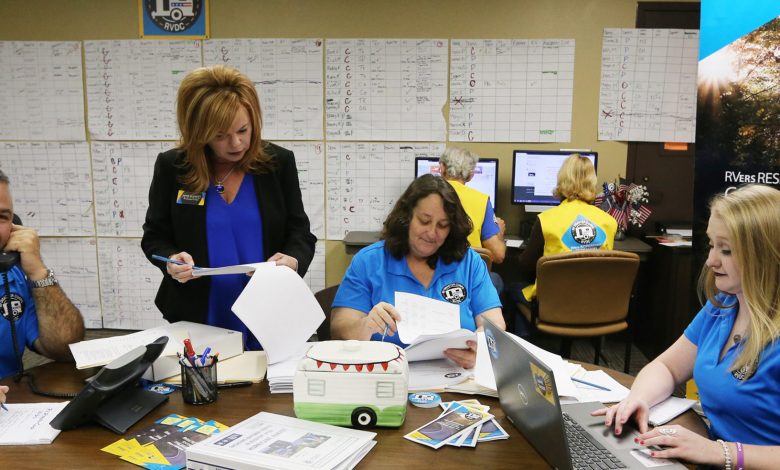RVDC to the Rescue!

When natural disaster strikes, RV Disaster Corps volunteers ride to the rescue – literally.
The Waco, Texas-based nonprofit group vets, organizes and deploys RVer volunteers, who deploy to areas in the U.S. impacted by natural disaster to assist with multi-agency recovery efforts.
Launched in September 2016, RVDC seeks out RV owners aged 55 and older. Most of the nonprofit group’s recruits are retired or semi-retired, so they have the availability to travel and serve for extended periods, according to RVDC Volunteer Coordinator Jamie Allnutt.
Allnutt likens RVers to turtles who have their houses with them, and there- fore don’t impact the scarce housing resources often seen in places hit by natural disasters.
“What I’m finding is that these Baby Boomers are eager to contribute. They’ve had a profession, or two or three, and have skills and knowledge,” she says. “They’re adventurous and taking the opportunity to do this.”
Answering the Call
The talents of RVDC volunteer were put to the test in late 2017 in the aftermath of Hurricane Harvey. According to the National Oceanic and Atmospheric Administration, Hurricane Harvey made landfall in August 2017 on the Texas coast as a Category 4 hurricane. With wind gusts of 130 mph, it dumped more than 60 inches of rain, making it the first major hurricane to make landfall since Hurricane Wilma in 2005. It caused some $198 billion in damages to parts of Texas and Louisiana.
RVDC volunteers have served in four cities near the Texas coastline that were severely damaged – Port Aransas, Refugio, Rockport and Texas City – to augment long-term recovery efforts. Allnutt says the entire coastal bend and Houston areas will be in recovery mode for years, and volunteers will be needed for many months.
“Since Harvey, we’ve deployed between 24 and 30 RVDC folks and … we have a dozen or more scheduled to deploy in the future,” she says. “I am actively recruiting RVDC members to schedule time to serve and to plan their spring and summer travels around volunteer service time.”
A number of RVDC volunteers were sent to San Antonio, where the state of Texas had temporarily set up a centrally located multi-agency ware- house. Allnutt says the massive amount of donations received for those affected by the hurricane were too much for the local municipalities to deal with. So, RVDC volunteers sent to the San Antonio warehouse picked up the goods, sorted, cataloged and re-distributed them as needed to agencies serving the survivors.
RVDC volunteers Elsie Preciado and her husband, Oscar, volunteered for seven weeks at the San Antonio warehouse. Most of their energy was used to unload pallets of donations, such as clothing, food goods, toiletries and pet food and supplies, and then sort and repackage these by category. Elsie Preciado says the couple worked a regular work week, from 8 a.m. to 5 p.m., Monday through Friday.
“We had to go through probably 100 pallets or more. The donations would come into the room and we broke them down, checked for broken products, repackaged everything so that it was a manageable size and then labeled it and got it on the floor where it would be picked up,” she recalls. “It (the warehouse) wasn’t climate controlled. So, some days were pretty hot. But we just managed to drink as much water as possible and keep ourselves moving.”
Elsie Preciado says the couple came across RVDC while searching online for ways RVers could help hurricane survivors.
“We have an RV. We’re both retired. And we can just jump in it and go,” she says. “RVDC was the first agency that popped up and … my husband said, ‘I think we’re supposed to go help them.’”
After researching the program, filling out an online application and taking the required test, the Preciados were soon contacted by RVDC and presented with an immediate assignment.
“About three days later, they called us to let us know they’d received all of our info and asked when we’d be able to go,” Elsie Preciado says. “They said people usually go for a week or two. My husband said, ‘We can go for two months.’” Elsie Preciado says RVDC staff were helpful throughout the entire process: recommending RV parks where they could stay once they reached their assignment, constantly providing them with updates on the needs of the warehouse where they’d be volunteering, and by making sure everything was going well. At the end of the day, she says, the volunteer work they were able to do through RVDC allowed them to help others.
“We were exhausted. I had bruises … I lost about 7 pounds,” she says. “It was wonderful.”
Elsie Preciado adds that she and her husband plan to do more volunteer work through RVDC in the coming weeks.
Al Pearce and his partner, Laura Erwin, also volunteered for eight days at that same warehouse.
“Our job was to sort the pallets of donations as they came in so that these could be repackaged and labeled for easy access to those in need,” says Pearce, a licensed RV inspector with his own business – A&L RV Inspection. “We went away with a lot.”
The couple first learned about RVDC through a radio show in San Antonio. They liked the concept and decided to sign up. What was attractive, Pearce says, was the primary use of people ages 55 and up with their own RV.
“They’re either retired or semi-retired, have a lot of experience in life, and have a certain work ethic that some people don’t have,” he says. “We’re both 60 years old working with 20-year-olds, and I think some days we outworked them. They gave us a task and we did it. And they appreciated that. We were invited back.”
Meeting a Need
On the flip side, the self-sufficiency of RVers volunteering in areas impacted by natural disasters is invaluable to those overseeing disaster relief and recovery centers. Ann Lopez, a county commissioner for Refugio County in Texas, and co-director of the Refugio County volunteer reception center, says she didn’t know the RVDC existed until she got a call from Allnutt. The volunteer reception center first opened in November to address longterm recovery for survivors in Refugio County.
“I’m so excited that they’re coming in because they’re most needed. We are a very small county, with a little over 7,000 people,” Lopez says, adding that what’s most attractive about RVDC volunteers is that they have their own accommodations. “We don’t have to look for housing for them because they carry their own house with them.”
Lopez, whose own home suffered heavy damage, says there are a number of low-income families in Refugio County who live in older homes and now may not have roofs or siding.
Joe Campian, managing director for Gulf Coast Interfaith’s disaster relief service center in Galveston County, says his agency appreciates the help that RVDC has provided in the hurricane’s aftermath.
“I focused in on the fact that there were volunteers and we really needed volunteers to help unload the trucks or drive a forklift or position pallets,” he says. “All of them were willing to help out in any way. They were very much a part of our million-dollar recovery efforts.”
Campian says the help of the RVDC volunteers has been especially helpful in areas of Galveston County that were farther inland, where residents didn’t have flood insurance.
Spreading the Word
RV Disaster Corps is a relatively modest-sized organization. The majority of its $100,000 funding comes from the Senior Corps, a division of the Corporation for National and Community Service; the remainder comes from state and private entities.
Despite its limited finances, the RVDC is expanding notably in size and scope thanks to the energetic efforts of its staff. Allnutt and RVDC Program Director Susan Copeland have been working to spread the word about the nonprofit and to find more volunteers. Among those efforts, they have attended RV rallies, put an ad in the Texas Highways magazine, and networked with groups such as the Texas Parks and Wildlife system, the Texas RV Association and the RV Dealers Association.
The goal is to educate the RV industry and other groups about how RVDC can help, according to Allnutt, who notes those efforts have been paying off, as industry officials are taking notice of the program and pointing RVers in its direction.
Phil Elam, executive director of the Austin, Texas-based TRVA, first learned about the RVDC via an ad in a magazine. “I discovered them literally while reading a magazine at my home. … The next day I called them and arranged a meeting,” Elam says. “We sat down and discussed the project and I knew immediately that this was something my trade organization would get behind and encourage others to do as well.”
He says he is a big believer in RVDC’s mission and that TRVA has been working to promote the nonprofit.
“I think they’re in the early stages of being a real viable organization as more RVers desire to help others in need,” he says.
RVDA President Phil Ingrassia says he believes RVDC’s mission is a positive way for RVers to give back to those in need. So, when Hurricane Harvey hit, Ingrassia says, RVDA did its part to let its members know how they could help.
RVDC’s “message, the advice and coordination that they provide, is valuable for RVers who want to help,” Ingrassia says. “RVers can be in a unique position to help because they’re bringing their own accommodations and don’t put additional stress on housing when it’s needed elsewhere.”
Allnutt says that nearly 300 individuals have applied to be part of RVDC’s disaster relief volunteers, of which 157 of those have gone through the training and are officially set as volunteers in some 40 states, as well as in Canada.
Allnutt says the requirements for becoming a volunteer are simple: pass an assessment and training similar to that provided to volunteer FEMA workers. RVDC volunteers must complete four modules and four assessments that are designed to be easily completed in less than two hours.
“Additional training modules are under development to include donations management, emergency response, and the long-term recovery process,” Allnutt says.
Goals for 2018, she says, are to raise $75,000 for further expansion. RVDC is already developing service opportunities beyond Texas.
The fledgling nonprofit was the brainchild of Senior Corps volunteers serving victims of the fertilizer plant explosion in West, Texas, in 2013, who noticed a need for long-term or ongoing relief for disaster victims, according to Allnutt.
“We (Senior Corps staff ) were involved in helping West recover and were challenged by the fact that so many volunteers were coming in or wanting to come in and we had no housing available. The housing for folks like that quickly filled up. You had displaced residents who were occupying what’s available and then you have every church and gymnasium that’s still standing filled with volunteers,” says Allnutt, a survivor of the West explosion whose home was less than a mile away. “We were brainstorming, and out of that came the idea that we needed volunteers that have their own campers.”

